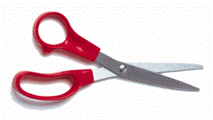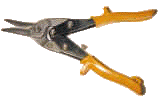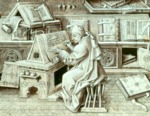scagliola - See stucco.
scale - A ratio (proportion) used in determining the dimensional relationship (analogy) between a representation to that which it represents (its actual size), as in maps, architectural plans, and models. This is often expressed numerically as two quantities separated by a colon (:). For example, a scale noted as "1:50." This scale would be read "one to fifty," meaning "one unit of measurement [inches, feet, meters, etc.] here represents fifty of the same units at full size." A size equal to actual size is full-scale. Sometimes scale is called "proper proportion."
Also see caliper, close-up, human scale, imbrication, pantograph, pointing and pointing machine, puppet, scaling up, and visual scale.
scaling up - A mechanical method of copying a small sculpture on a larger scale by increasing all the measurements proportionately, using such measuring devices as a scaling board, caliper, or pointing machine.
 scanner
- A device for capturing a digital
image. Scanners are used in conjunction with a computer, so
that once captured, images can be manipulated
using graphics software.
scanner
- A device for capturing a digital
image. Scanners are used in conjunction with a computer, so
that once captured, images can be manipulated
using graphics software.
Related link:
Also see copystand, drum, flatbed, infrared reflectography (IR) and reflectogram, moiré, monitor, new media, Photoshop, and slide scanners.
scanning - See image capture and scanner.
scarab - A representation of a certain beetle (a scarabaeid beetle), which the ancient Egyptians considered sacred. It was usually a ceramic or stone sculpture or a cut gem, used in ancient Egypt as an amulet or talisman, or as a seal, as symbolic of the soul. Also called a scarabaeus.
Examples:

Egypt, Western Thebes, Scarab of Wah, c. 1990-85 BCE,
early Dynasty 12, Middle Kingdom, silver,
gold, length
1 1/2 inches (3.8 cm), Metropolitan Museum of Art, NY. Scarabs
in silver are rare.

Egypt, Western Thebes, Heart Scarab of Hatnofer, c. 1466 BCE,
Dynasty 18, reign of Hatshepsut, New Kingdom, gold, green
stone, 2 5/8 x 2 1/4 inches (6.7 x 5.3 cm), Metropolitan
Museum of Art, NY.

Greece, attributed to Epimenes, Scarab with an archer testing an arrow,
c. 500 BCE,
Archaic, chalcedony, length
11/16 inches (1.7 cm), Metropolitan Museum of Art, NY. This image
is carved into the underside
of the scarab.
scarification - Cosmetic
puncturing of the skin to produce permanent
welts or scars for decorative
or expressive effect. A form
of body art, scarification
is related to tattooing, though it
introduces no pigments. Scarification
has been practised by native peoples of Australia, Borneo, Canada's
province of British Columbia, Mexico, New Guinea, New Zealand,
and the USA's state of Washington. The people of Papau New Guinea,
for instance, cut their skin and insert clay or ash into the wounds
so as to develop permanent bumps (known as keloids or weals).
This painful ritual makes them well respected members of their
tribe who are honored for their courage and endurance. Although
tattooing and piercing continues to be the more commonly practised
forms of body art, an increasing number of people in North America and Europe are participating
in scarification. Scarification presents numerous serious health
concerns — including risks of physical injury, infection by bloodborne
pathogens, and psychological harm as well — because it either
borders on or is self-mutilation. Far more often than not, allowing
oneself to be cut or intentionally cutting oneself indicates a
need for professional medical assistance.
Examples:

M. F. Peron (French), illustration from Voyage
de Decouvertes aux terres Australes, 1804. This Australian
Aborigine displays scarification on his face, shoulders and chest,
along with face paint and nose piercing. At that time, Aborigines
widely practised scarification, and said that each deliberately
placed scar expressed something
about endurance, identity,
status, beauty, courage,
sorrow or grief. Two hundred years later, scarification is now
restricted almost entirely to parts of Arnhem Land.

Middle Sepik, Sawos People, Marap Village,
Male Crocodile Scarification,
c. 1990s, keloids.
Also see hazardous, pain, sense, and sensuality.
schematic stage - The third of the Stages of Artistic Development named and described by Victor Lowenfeld, it typically occurs in children during the ages of 6 to 9. This stage is typically preceded by the preschematic stage (4-6) and followed by the dawning realism stage (9-11). Others refer to the preschematic and schematic stages as the period of symbolism.
Related links:
Also see children's art.
schist - A metamorphic rock of dark silvery gray color, sometimes tending toward blue or green. A beautiful variety that is among the lowest strata of rock in Arizona's Grand Canyon is "Vishnu schist."
(pr. shist)
Examples:

Pakistan, ancient region of Gandhära,
Torso of a Standing Bodhisattva, Kushan
period (c. late 1st-3rd century), c. late 1st - 2nd century,
schist, height 64 1/2 inches
(163.8 cm), Metropolitan Museum of Art, NY. See Bodhisattva
and Buddhist art.
![]()
Attributed to Bengal, India, Sultanate, Dedicatory inscription from a mosque in tughra
script, panel, 905 A.H.
/ CE
1500, black schist, 16 1/8 x 45 5/16 x 2 3/4 inches (41 x 115.1
x 7 cm), Metropolitan Museum of Art, NY. See Islamic art.
Note: Artists, when greatly dismayed or surprised, have been known to exclaim, "O SCHIST!"
scholars' rocks - See suiseki.
school - A group of artists whose style demonstrates a common origin or influence. A common origin is likely to be geographic (for example, Dutch school, or Viennese school, or New York school), but refers to the stylistic tendencies of artists in that area. A common influence may be a period, a movement (for example, Impressionist school), an attitude (for example, naturalist school), or a particular artist (for example, school of Rembrandt). When applied to a particular painter, this may either mean that the work in question was painted in that artist's studio by one of his pupils or assistants (apparently with a certain amount of the master's guidance), or that it is an imitation or copy of his or her work. Related terms are circle of, follower of, manner of, and workshop of.
Also see marbling.
school of Burgundy - See Burgundy, school of and Gothic.
science and art - Science is the observation, identification, description, experimental investigation, and theoretical explanation of phenomena — both man-made and natural. Scientific activities involve a large amount of study and methodology — as when using the "scientific method." The principal sciences are: mathematics, astronomy, chemistry, physics, geology, biology, botany, zoology, archaeology, engineering, medicine, and psychology.
The academic disciplines in any school's curriculum are usually divided into the arts and the sciences. Sometimes this division is framed as the humanities and the sciences, or the arts and humanities are together often placed opposite the sciences. Each of these largely excludes the other from its arena. This is necessary for the organization of the entire field of academic disciplines. There is no instance, however, in which either one is entirely separate from the other. Everything has both artistic and scientific qualities. Any effort to separate them entirely is utterly misguided. Historically, the arts have many interdisciplinary connections to the sciences. There have been an increasing number of them ever since the arrival of postmodernism.
Quote:
Related links:
Also see action research, anatomy, angstrom, architecture, art therapy, ASTM International (American Society for Testing and Materials), Bloom's Taxonomy, bone structure, cartography, change, cognitive, dimension, empirical, empiricism, epistemology, ergonomics, horology, hygroscopic, hygrothermograph, kinesiologist, map, measurement, metallurgy, metamorphosis, Mohs Scale of Hardness, multiple intelligence theory, mystery, ontology, ophthalmology, optics, optical illusion, optical mixing, perception, periodicity, phenomenology, photography, Renaissance, research, sight, space-time, standards, stereometry, technology, temperature, theory, time, typology, and weight.
 scissors - A hand-held cutting tool
made up of two crossed and connected blades whose (inner) cutting
edges slide past each other as they pivot to open and close. Each
blade is extended from a ring-shaped handle (called bows) through
which a user inserts opposing fingers. Scissors are commonly employed
to cut such thin materials
as string, hair, fabric, paper and
sheets of other kinds, such as cellophane,
foil, etc. "Scissors"
can be used either as a singular or as a plural word, and is often
referred to as a pair of.
scissors - A hand-held cutting tool
made up of two crossed and connected blades whose (inner) cutting
edges slide past each other as they pivot to open and close. Each
blade is extended from a ring-shaped handle (called bows) through
which a user inserts opposing fingers. Scissors are commonly employed
to cut such thin materials
as string, hair, fabric, paper and
sheets of other kinds, such as cellophane,
foil, etc. "Scissors"
can be used either as a singular or as a plural word, and is often
referred to as a pair of.
Children should be advised about safely handling scissors: how to aim their cutting, how to hold them while walking, etc.
There are a number of specially designed scissors. These include:

School or safety scissors are smaller to
fit small hands, and the ends of their blades are very rounded.
Left-handed scissors have a cutting action opposite to those for right-handers, making them easier for left-handed people to use.
Larger scissors are often called shears.
Pinking and serrated scissors have fine "teeth"
along the cutting edge of one or more of the blades. Serrated
scissors can be preferrable to ordinary ones because some materials
and round objects tend to slip ahead of ordinary cutting blades
while being cut, but are held in place by serrated edges.

Scissors used for cutting thin metal sheet
or thick metal foil are called snips
or tinsnips.

In 2006 an American mother was amused by her five-year old son's drawing of scissors. She made this scan, and emailed it to someone who forwarded it to ArtPage. She wrote: "This is my kindergartener's artistic rendering of a pair of scissors. I wonder what his teacher thought. And I am so dang proud of myself. I allowed myself just a small smirk when I saw it. I waited until he was out of the room before I started to cry from laughing so hard."
Related resources:
Also see guillotine.
sclera - The anatomical name for the whites of the eyes. Also see caruncle, iris, pupil, and sight.
scoring - To make scratches or creases in pieces of clay to be joined together. Scoring and applying slip to such roughened surfaces creates a bond that holds the pieces together. If slip acts as an adhesive, and scoring makes two pieces of clay like the opposite sides of a zipper, their combined action — a zipped zipper with hardened adhesive inside — should be permanent. See coil and slab construction.
 scraper - Sometimes called a spatula,
any tool with a blade that
is somewhat flexible, but fairly rigid. It is generally used for
modeling such soft materials
as clay, paint,
plaster, and
wax. Its edge
is not beveled to the degree
that it would cut or carve
hard materials. Scrapers can be made in a variety
of sizes, and
scraper - Sometimes called a spatula,
any tool with a blade that
is somewhat flexible, but fairly rigid. It is generally used for
modeling such soft materials
as clay, paint,
plaster, and
wax. Its edge
is not beveled to the degree
that it would cut or carve
hard materials. Scrapers can be made in a variety
of sizes, and  typically of metal,
plastic, wood,
horn or seashell. Although
their edges are often broad and straight
or curved, scrapers with edges
having other shapes — close
to the contours
typically of metal,
plastic, wood,
horn or seashell. Although
their edges are often broad and straight
or curved, scrapers with edges
having other shapes — close
to the contours  of surfaces needing scraping — can be very useful. Historically among the oldest kinds of
tools, scrapers are often used for removing materials from surfaces,
for spreading or smoothing them.
of surfaces needing scraping — can be very useful. Historically among the oldest kinds of
tools, scrapers are often used for removing materials from surfaces,
for spreading or smoothing them.
Example:

Australian Aborigine, Scraper / Digger, 20th century, shell,
wood, and wax,
Queensland Department of Education. See Aboriginal
art.
Also see chisel and palette knife.
screenprint - See silkscreen and prints and printmaking.
screenshot - See screen.
scribble - Chaotic or meaningless marks (usually lines), or what many would think were chaotic or meaningless marks, but may in fact have some order or meaning. Scribbling is widely understood to be a necessary first stage in every child's artistic development.
Scribbles are among the least highly regarded forms of art, because:
Examples:

Hans Hartung (French, born Germany, 1904-1989),
T 1973, E-13, 1973, oil
on canvas, 111 x 180 cm, Tehran
Museum of Contemporary Art, Iran. See abstraction
and diagonal.
Phillip (age 2), Scribble, crayon
on paper.

Tina D. (a child with severe disabilities,
grade 2), Drawing, 12 x 18 inches, oil
pastel on oak tag, Fairview
School, Darien, IL.

Elliot Strunk (American, contemporary graphic designer), A Frantic Scribble or Something More?,
2001, mixed media collage,
Strata Magazine, issue 3, publication discontinued. The artist said, "I decided one
afternoon to chart the movement of my mouse across the desktop.
The pattern [you see here] is the result after two hours of work." See movement and pattern.
Also see chaos, erasure, and scribble stage.
scribble stage - The first of Victor Lowenfeld's Stages of Artistic Development. Lowenfeld said the scribble stage typically occurs in children's drawings and paintings at 2-4 years old, and that it is made up of four sub-stages:
Related links:
Also see scribble, preschematic stage (4-6), schematic stage (6-9), dawning realism stage (9-11), and the pseudorealistic stage (11-13).
scribe - A metal tool with a sharp point used to draw fine accurate lines on a rigid material such as metal or plastic sheet. Also a person whose profession is writing by hand.
Also see paper, papyrus, parchment, and text.
scrim - A coarse, loosely woven hessian fabric which acts as reinforcement for plaster models and casts.
scripophily - A branch of numismatics, the study or collection of financial documents — such works on paper as certificates of stock, bond, deed, etc. Short of framing them, a preferred means of storing and displaying scripophily is in polypropylene sheet protectors.
Also see deltiologist, engraving, ephemera, exonumia, philately, and solander box.
scriptorium - A room in a monastery in which books and scrolls are written, copied, illuminated, and housed. This was especially significant during the Middle Ages, when scriptoriums (another plural form is scriptoria) served as the principal European sites for the production and preservation of manuscripts. They were found in almost every monastery after the 8th century.
Example:

A medieval depiction of a monk at work in a monastic
scriptorium. This picture is greatly detailed in its rendering
of the room's furnishings, the writer's materials, equipment,
and activity.
Related link:
Also see bookbinding, calligraphy, codex, illumination, manuscript, miniature, monasticism, palimpsest, paper, parchment, rotulus, and vellum.
sculpto-painting - A term first used to describe works by Alexander Archipenko (1887-1964), Ukrainian-born Modernist sculptor, who lived and worked in France and the USA.
Quote:
sculptor - One who produces sculptures. Tanagra sculptors were called "coraplasters" (in Greek, cora is a girl, plastein means to sculpt), as they were particularly drawn to representing women. Nearly all of the earlier figurines represented deities. Another archaic synonym for sculptor is statuary.
Quotes:
Also see art careers, form, Pygmalion, space, and statue.
sculpture garden and sculpture park - Environments, all or mostly out of doors, which serve as a setting in which sculptures are exhibited.
Examples:

Storm
King Art Center's five hundred acres of landscaped lawns,
fields and woodlands provide the site for postwar sculptures
by internationally renowned artists. At Storm King, in Mountainville,
NY, the exhibition space is defined by sky and land. Unencumbered
by walls, the subtly created flow of space is punctuated by modern
sculpture. The collection includes works by Magdalena Abakanowicz,
Alexander Calder, Andy Goldsworthy, Barbara Hepworth, Henry Moore,
Isamu Noguchi, Richard Serra, David Smith, and others.
The Minneapolis Sculpture Garden at the Walker
Art Museum. With 11 acres, this is the largest urban sculpture
garden in the country. There are more than 40 works on permanent
view, including Claes Oldenburg and Coosje van Bruggen, Spoonbridge
and Cherry, 1987-88. Consider taking a virtual visit.

Andy Goldsworthy (English, 1956-), Stone Houses, 2004, two monumental
domes constructed
of wood (split rails from New England
agricultural sources) and stone
(from Scotland), each 18 feet in height
and 24 feet in diameter,
Metropolitan Museum, NY. This installation
is in the museum's Roof Garden, an outdoor space for sculpture
with a great view of the city. The museum says the work was "inspired by Central Park and
its architectural
backdrop. Inherent in these seemingly simple forms
are the implicit power, beauty,
mystery, and elemental aspects
of nature, marked
by the passage of time
and by human contact." See earth
art.
Other resources:
scumble — There are two senses for this term. Its earlier meaning: a broken passage of opaque or translucent color (often paint) skimmed or dragged across the surface in such a way that each color is visible, each modifying the other, or, to apply a color in this way. This technique was developed by the Venetian school of painters (chief among whom was Titian, c. 1488 - 1576), who passed dry, opaque coats of oil paint over a tinted background to create subtle tones and shadows. Although this painting technique dates to the 16th century, use of the word "scumble" in order to refer to it is unknown before the late 18th century. The origins of the word "scumble" are blurry [!], but the word is thought to be related to the verb "scum," an obsolete form of "skim" (meaning "to pass lightly over"). A later sense for scumble: to smudge or smear the lines, edges, or colors in an image by rubbing lightly. This use appeared in the mid-1800s.
Also see abrasion, brushstroke, dragging, dry brush, faux, glaze, marbling, overpainting, patina, Renaissance, sfumato, and underpainting.
https://inform.quest/_art